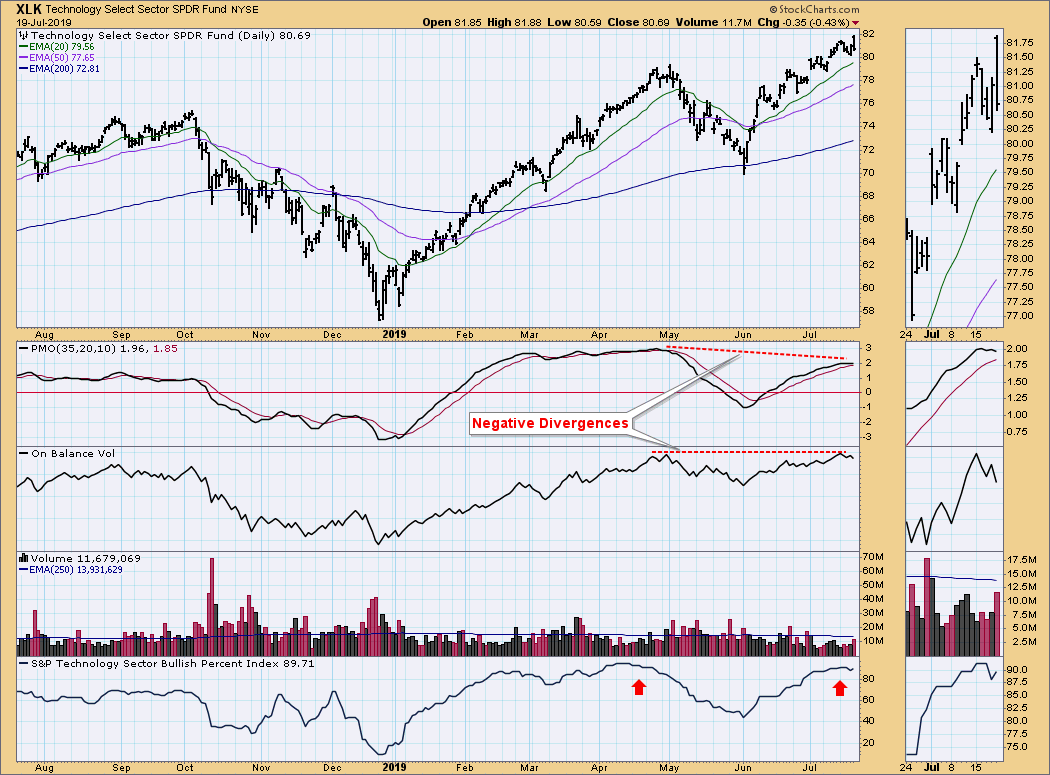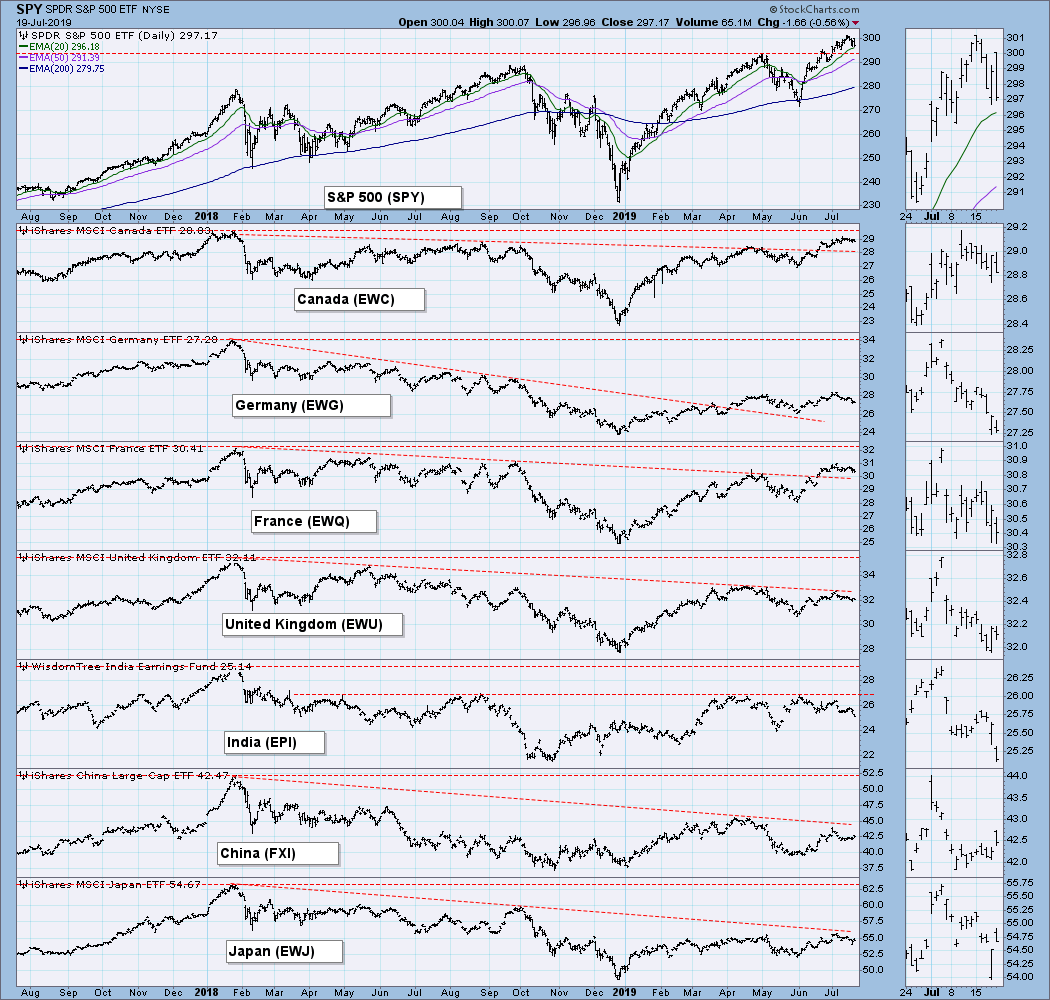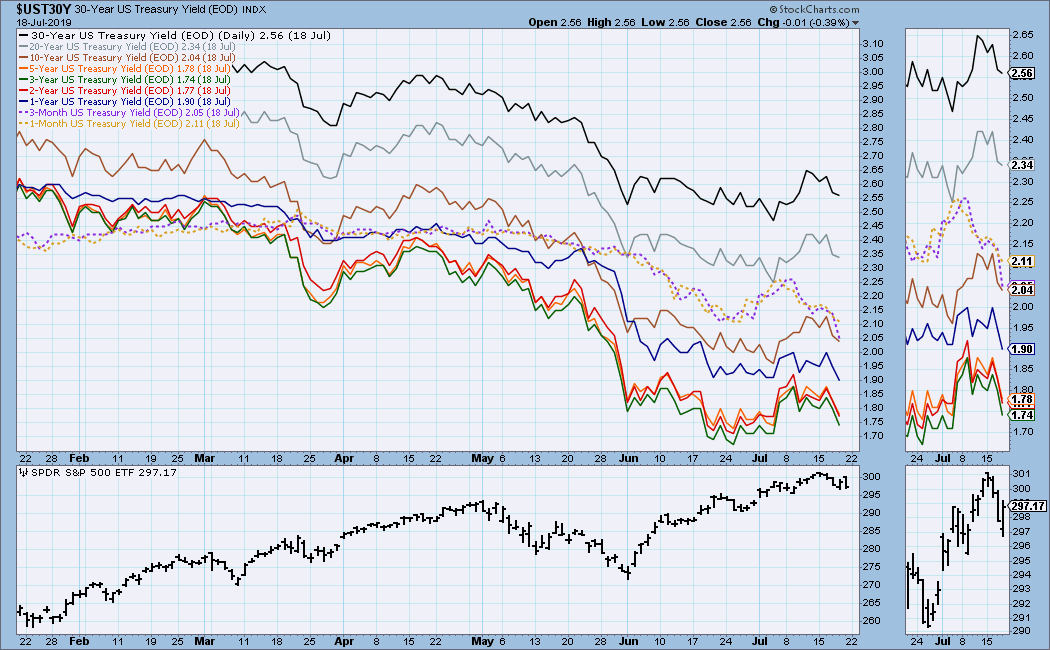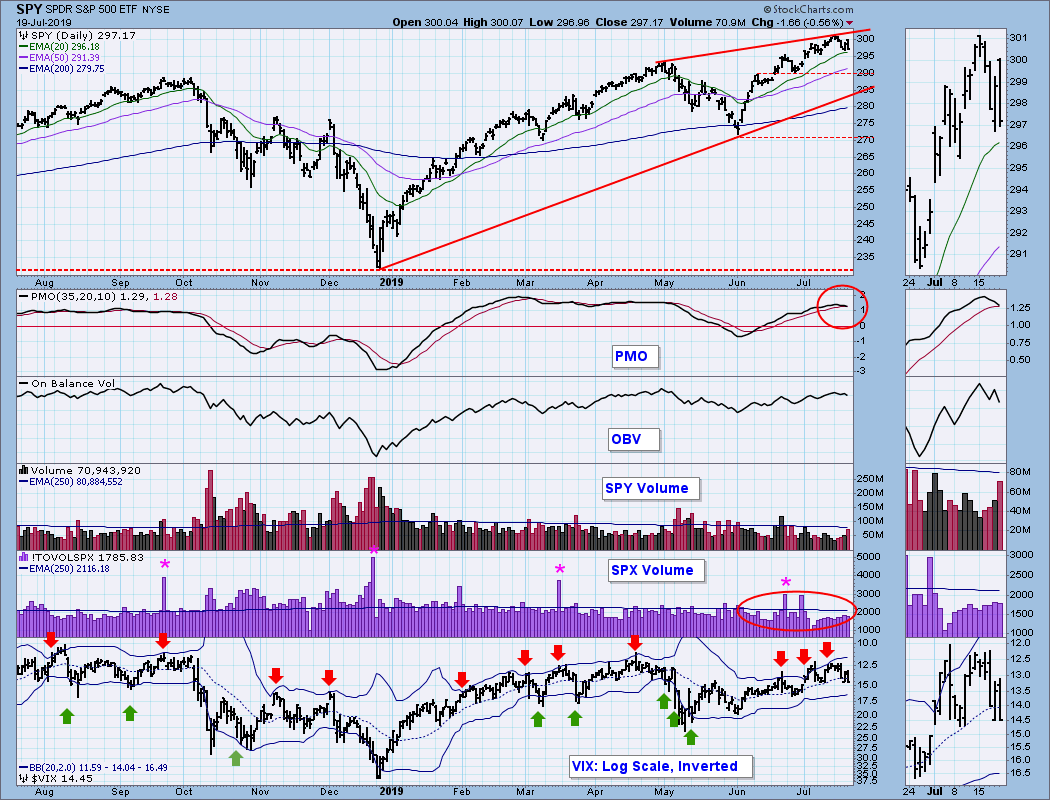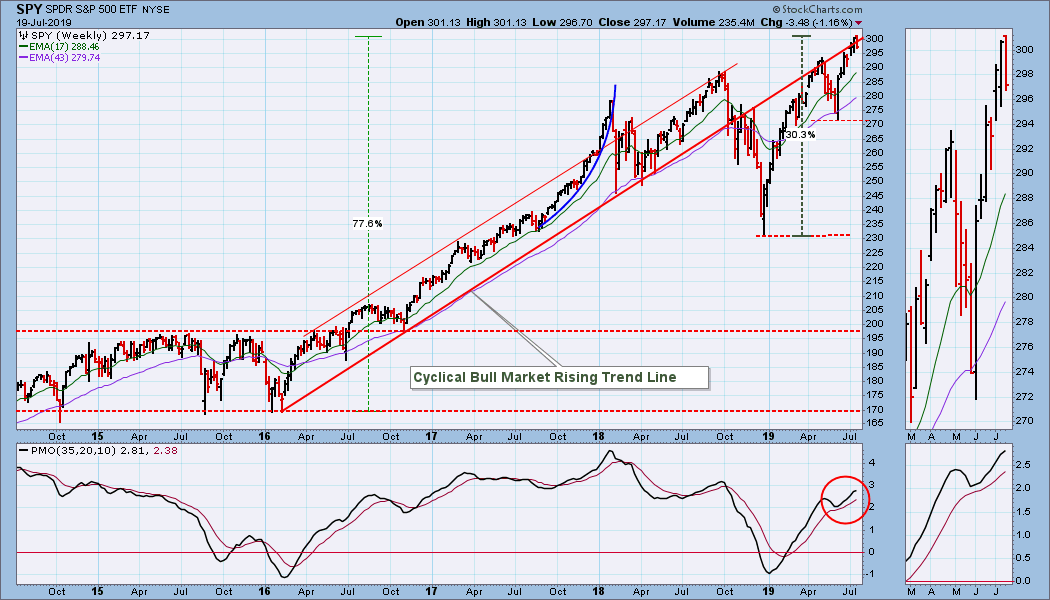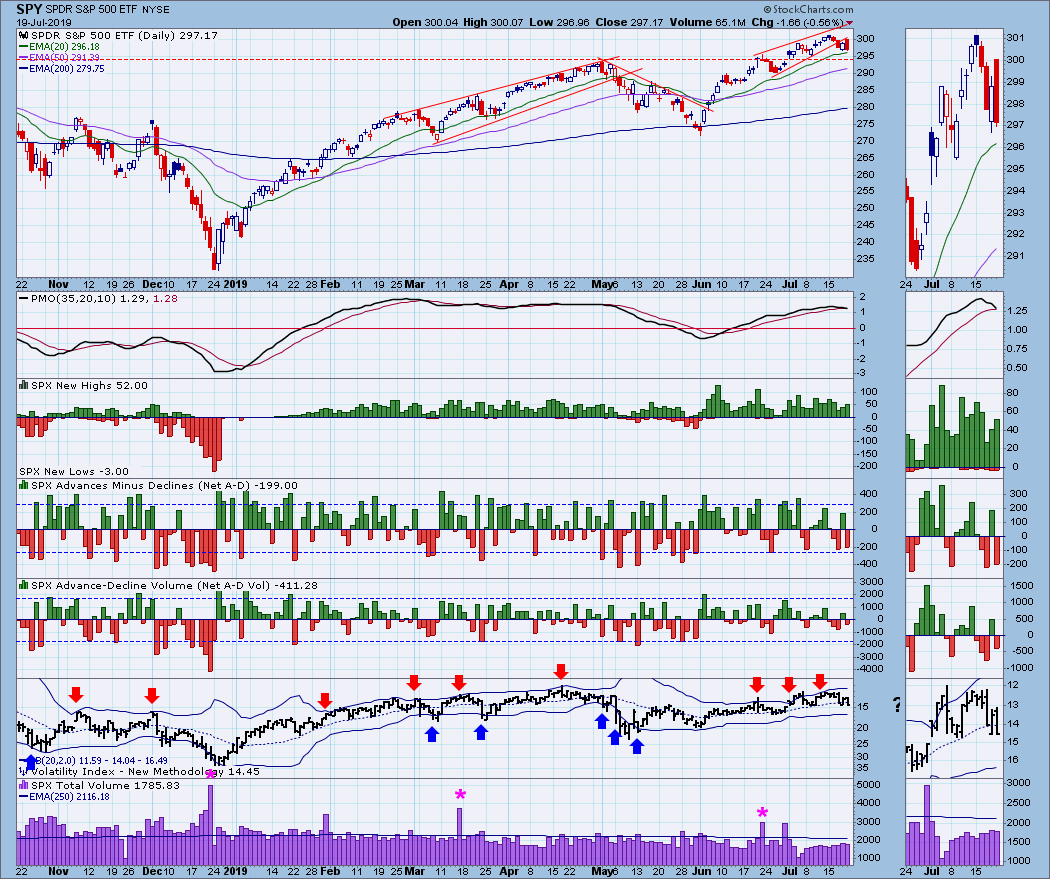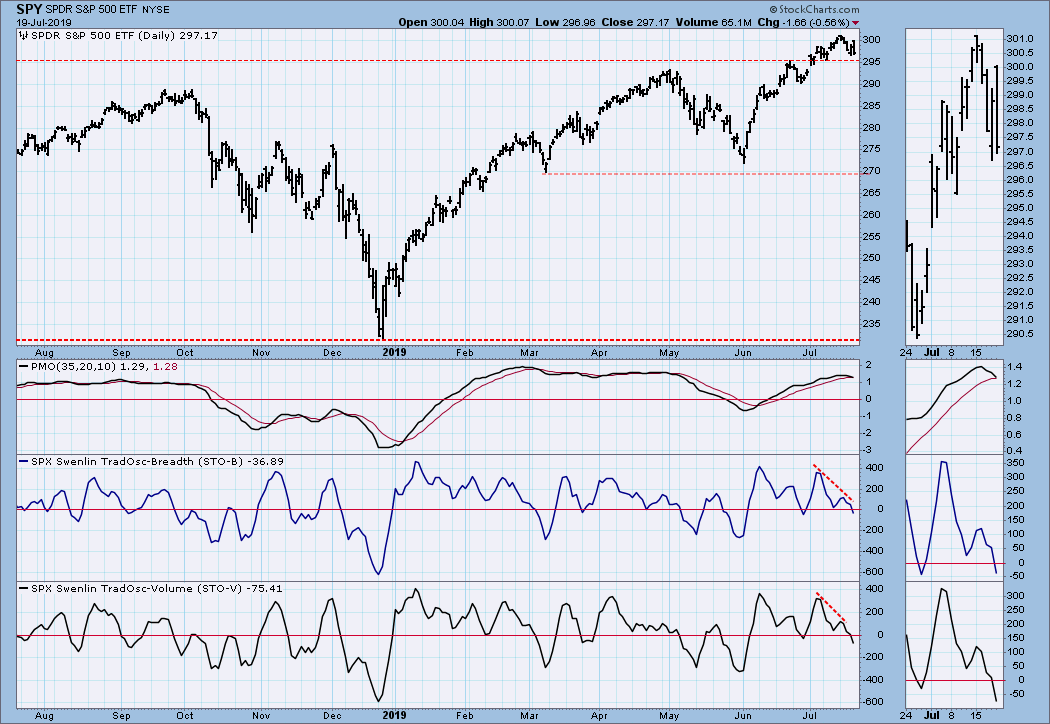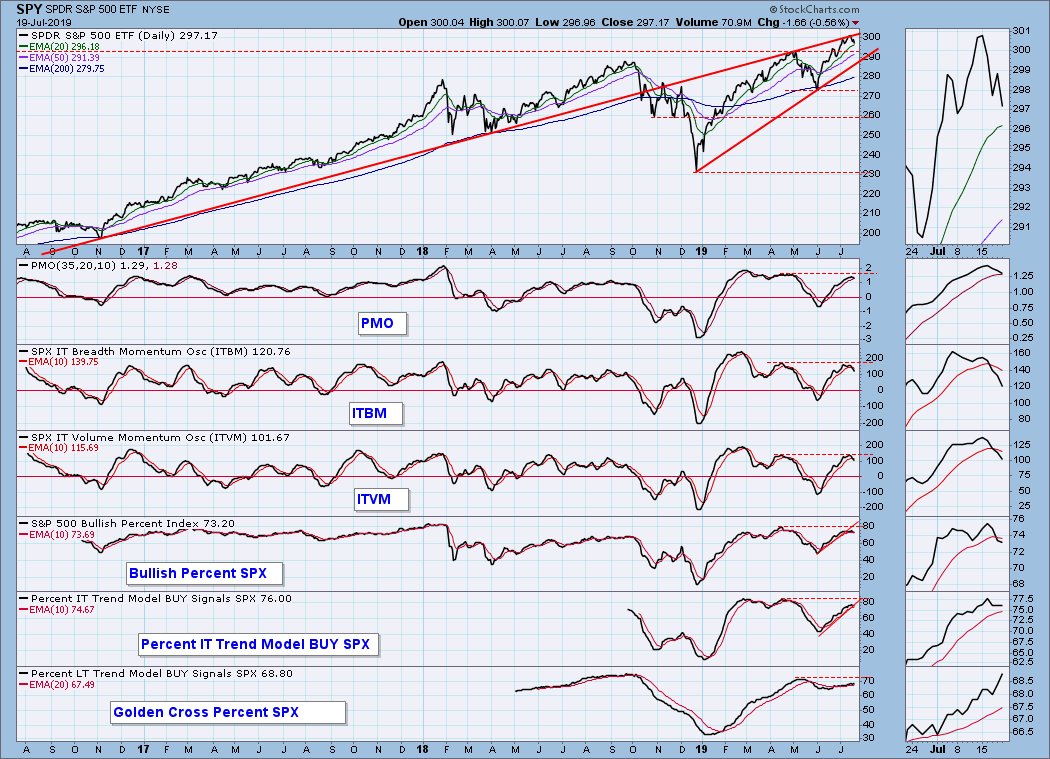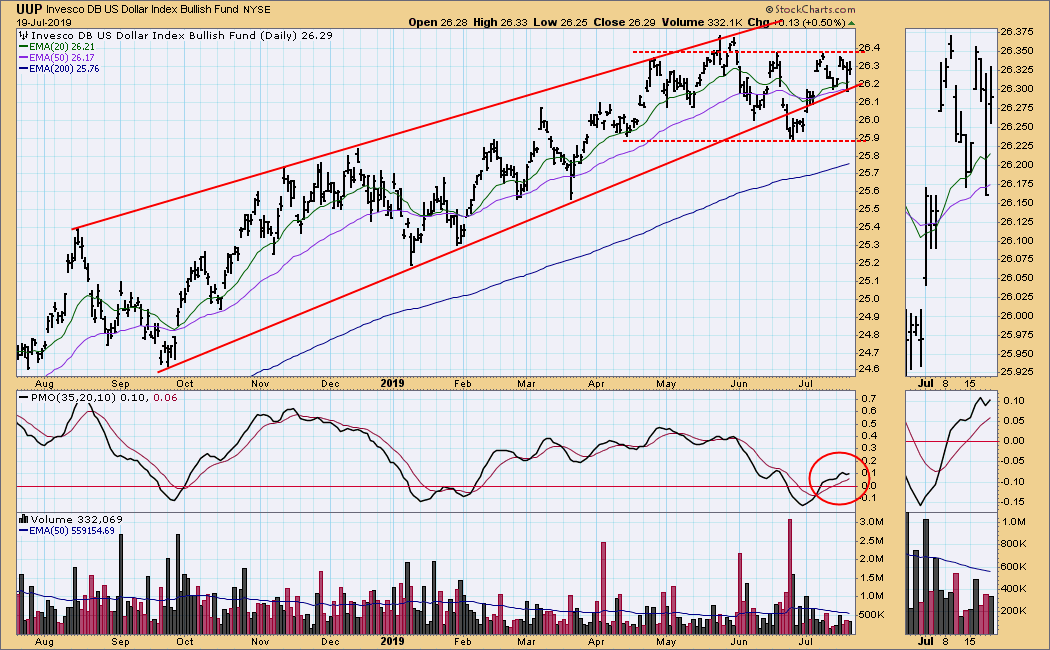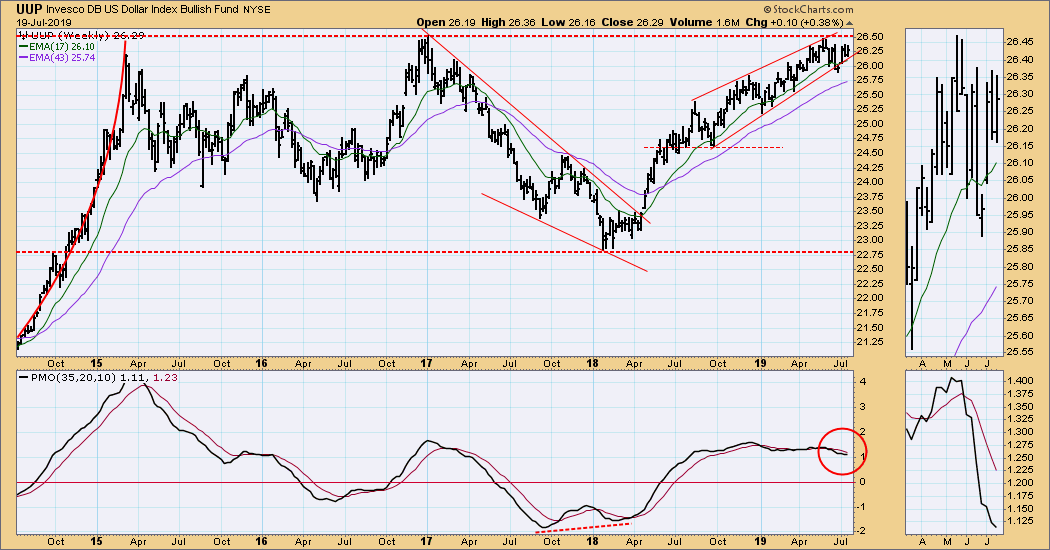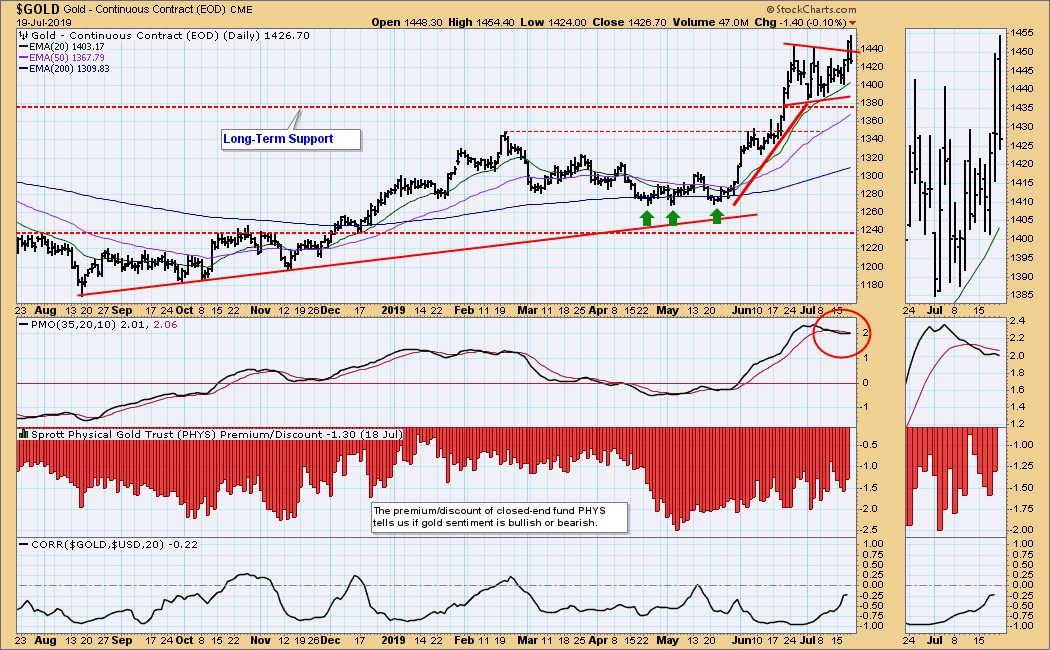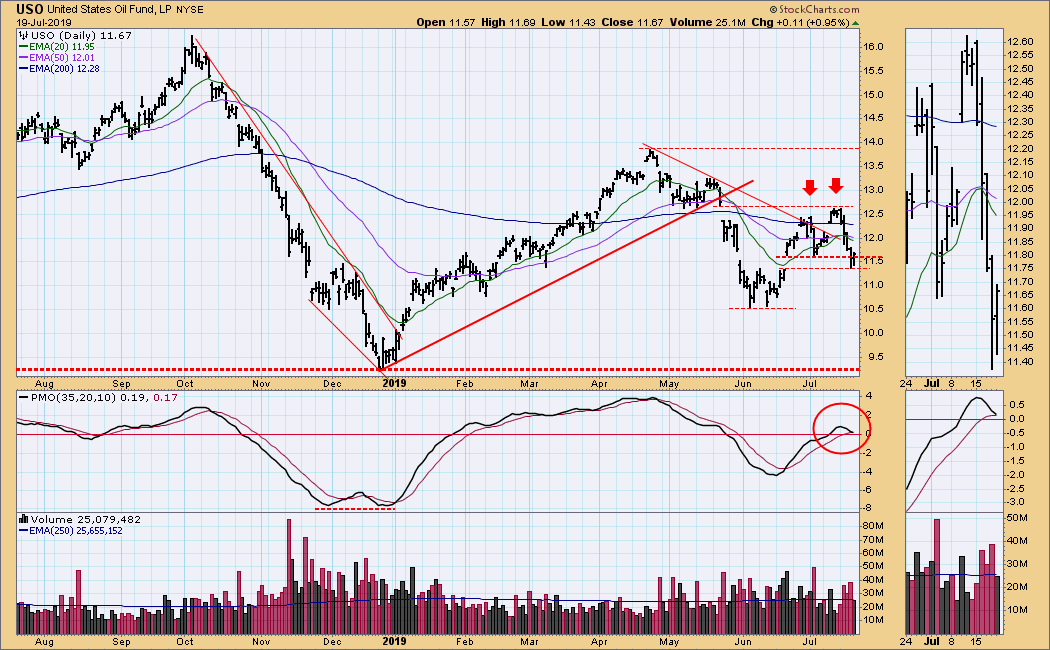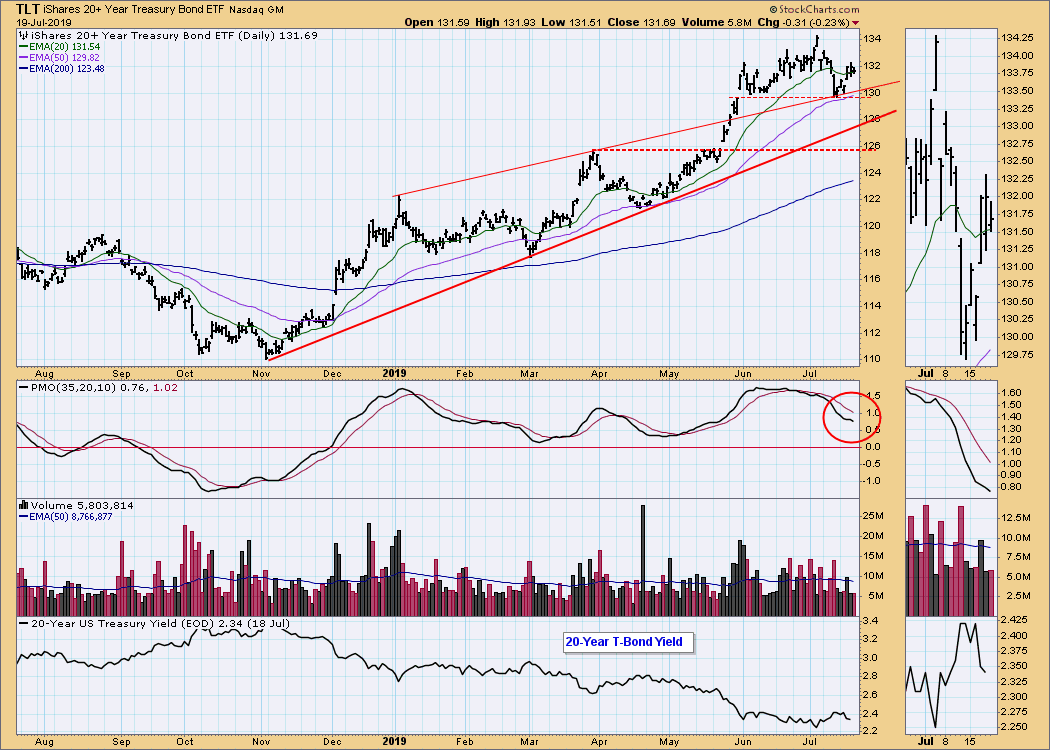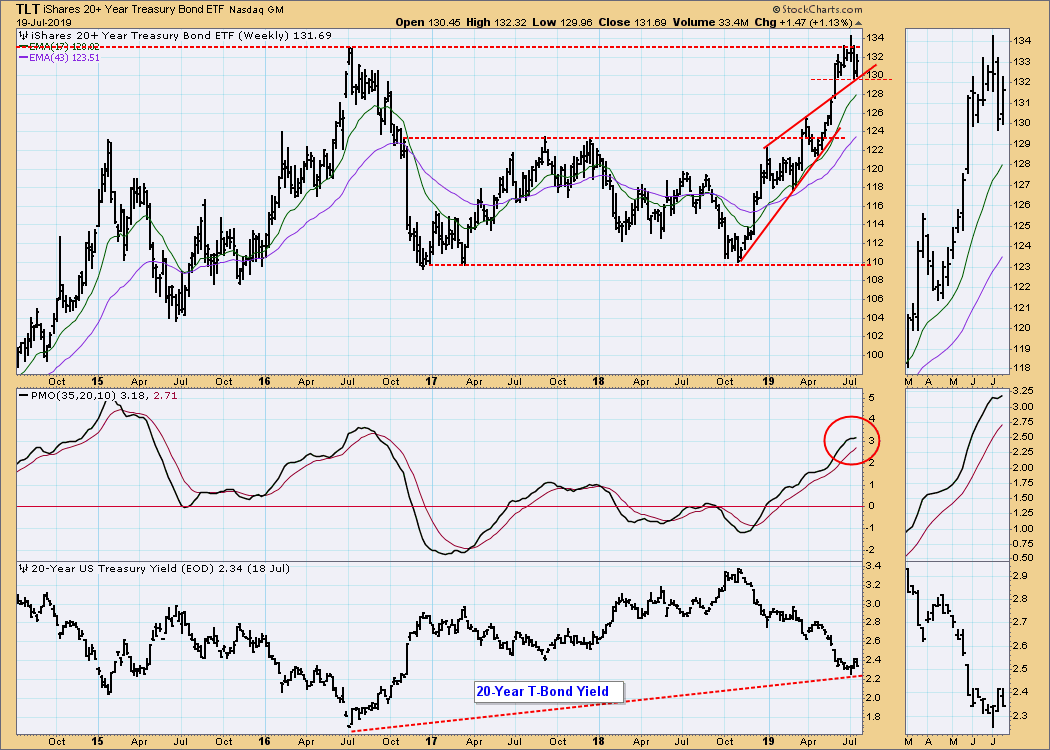
The Bullish Percent Index (BPI) shows the percentage of stocks in a given index with Point and figure BUY signals. Besides having a BPI for the major market indexes, StockCharts.com also has a BPI for each of the 11 Sector SPDRs, and I have started to display them with their respective sectors. The Technology BPI ($BPINFO) is at 90%, which shows excellent participation; however, it is likely that it has peaked and will start declining again. This will erode support of the sector index, and will probably result in a price decline. Also note that the PMO and OBV have negative divergences against price, offering more evidence of technical weakness.
The DecisionPoint Weekly Wrap presents an end-of-week assessment of the trend and condition of the stock market (S&P 500), the U.S. Dollar, Gold, Crude Oil, and Bonds.
Watch the latest episode of DecisionPoint on StockCharts TV's YouTube channel here!
GLOBAL MARKETS
BROAD MARKET INDEXES
Note that the BPIs have started to break their uptrend lines drawn from the June low. I believe it was last week that I said it was going to be a problem when those BPI uptrends were broken.
SECTORS
Each S&P 500 Index component stock is assigned to one, and only one, of 11 major sectors. This is a snapshot of the Intermediate-Term and Long-Term Trend Model signal status for those sectors.
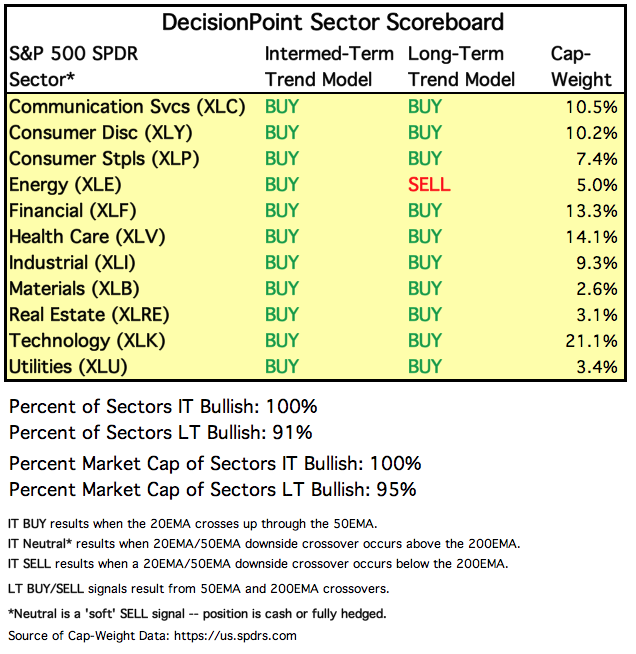
INTEREST RATES
Because some interest rates are currently inverted, I will be including a chart so we can watch the situation. In normal circumstances the longer money is borrowed the higher the interest rate that must be paid. When rates are inverted, the reverse is true. It is generally believed that rate inversions result from "a flight to safety." On the chart below, notice that the one-month and three month T-Bills (dotted lines) pay a higher interest rate than the one year through the 10-year T-Bonds. This is a serious problem for the stock market.
STOCKS
IT Trend Model: BUY as of 6/11/2019
LT Trend Model: BUY as of 2/26/2019
SPY Daily Chart: Price broke down from the rising wedge on Wednesday, and a rally attempt on Friday failed. There is a negative divergence on OBV, and S&P 500 total volume continued to be thin.
SPY Weekly Chart: This chart still looks bullish, but the PMO has decelerated somewhat.
Climactic Market Indicators: Nothing major to see here.
Short-Term Market Indicators: Both the STO-B and STO-V have negative divergences, and the STO-V has dipped lower than its June low.
Intermediate-Term Market Indicators: These indicators have rolled over and most have crossed down through their signal lines. The Golden Cross Percent is still rising, but it moves more slowly.
CONCLUSION: In spite of a probable July 31 interest rate cut, the market has started to roll over. On the chart above we can see a giant rising wedge, which we expect to resolve downward. Also on the chart above, the indicators are descending from relatively overbought levels, so a hefty decline can take place while they correct down to recent oversold levels, and it could really get ugly if they move down to their December lows.
DOLLAR (UUP)
IT Trend Model: BUY as of 7/5/2019
LT Trend Model: BUY as of 5/25/2018
UUP Daily Chart: As I said last week, price is chopping around in a ragged consolidation range, and it is hard to get any sense of direction.
UUP Weekly Chart: Long-term resistance seems to be containing price.
GOLD
IT Trend Model: BUY as of 6/3/2019
LT Trend Model: BUY as of 1/8/2019
GOLD Daily Chart: Gold tried to break out on Thursday, but the move failed. I'm still liking the bullish flag formation.
GOLD Weekly Chart: Price remains above long-term support, and the weekly PMO is very positive.
CRUDE OIL (USO)
IT Trend Model: NEUTRAL as of 5/30/2019
LT Trend Model: SELL as of 6/4/2019
USO Daily Chart: Crude fell out of bed this week. Price broke the confirmation line, then found support at the bottom of a gap. The minimum downside projection is around the June lows. It is interesting to see the oil market relatively uninterested in the face of the Strait of Hormuz activities.
USO/WTIC Weekly Charts: WTIC is still about midway a range between 42 and 76. The USO weekly PMO has turned negative again.
BONDS (TLT)
IT Trend Model: BUY as of 12/6/2018
LT Trend Model: BUY as of 1/2/2019
TLT Daily Chart: Price bounced off obvious support, but the daily PMO is below the signal line and falling -- not an ideal setup for a rally.
TLT Weekly Chart: In this time frame we can see a long-term resistance line drawn across the 2016 price top. The yield for the 20-Year Bond has room to go lower, so price could go higher.
**Don't miss any of the DecisionPoint commentaries! Go to the "Notify Me" box toward the end of this blog page to be notified as soon as they are published.**
Technical Analysis is a windsock, not a crystal ball.
Happy Charting! - Carl
NOTE: The signal status reported herein is based upon mechanical trading model signals, specifically, the DecisionPoint Trend Model. They define the implied bias of the price index based upon moving average relationships, but they do not necessarily call for a specific action. They are information flags that should prompt chart review. Further, they do not call for continuous buying or selling during the life of the signal. For example, a BUY signal will probably (but not necessarily) return the best results if action is taken soon after the signal is generated. Additional opportunities for buying may be found as price zigzags higher, but the trader must look for optimum entry points. Conversely, exit points to preserve gains (or minimize losses) may be evident before the model mechanically closes the signal.
Helpful DecisionPoint Links:
DecisionPoint Shared ChartList and DecisionPoint Chart Gallery
Price Momentum Oscillator (PMO)
Swenlin Trading Oscillators (STO-B and STO-V)

